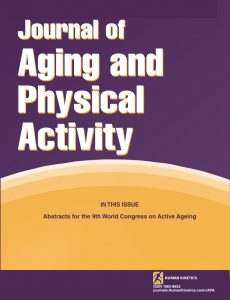Publications

Influence of Badminton Practice on Age-Related Changes in Patellar and Achilles Tendons
Authors: Alfredo Bravo-Sanchez 1, Pablo Abian 2, Filipa Sousa 3, Fernando Jimenez 1, Javier Abian-Vicen 1
Affiliations:
- Performance and Sport Rehabilitation Laboratory, Faculty of Sport Sciences, University of Castilla-La Mancha, Toledo, Spain
- Faculty of Humanities and Social Sciences, Comillas Pontifical University, Madrid, Spain
- Porto Biomechanics Laboratory (LABIOMEP), University of Porto, Porto, Portugal and CIFI2D, Faculty of Sports (FADEUP), University of Porto, Porto, Portugal
Journal: Journal of Aging and Physical Activity - October 2020, Volume 28, Issue 5 (DOI: 10.1123/japa.2020-0215)
-
Field & Applications:
- Sport
- Gerontology / Ageing
- Injury prevention
Regular sports practice could prevent age-related changes in tendinous tissues. The purpose of the study was to investigate the effect of regular badminton practise on patellar and Achilles tendon mechanical properties in senior competitive badminton players (>35 years old) and to compare the results with physically active people matched by age. One hundred ninety-two badminton players and 193 physically active people were divided by age into four groups, between 35 and 44 (U45), between 45 and 54 (U55), between 55 and 64 (U65), and over 65 (O65) years old.
A LogiqS8 transducer in elastography mode and a MyotonPRO myotonometer were used to assess patellar and Achilles mechanical properties. Achilles tendon stiffness was higher in the control group than the badminton players for the U45, U55, and O65 age groups (p < .01). Also, the elastography index was higher in the control group than the badminton players for the U45, U55, U65, and O65 age groups (p < .05).
In conclusion, regular badminton practise could prevent the decline in mechanical properties of the patellar and Achilles tendons.
Keywords: elastography, myotonometer, stiffness
In conclusion, older people’s patellar tendons are stiffer and have a higher tone (natural oscillation frequency) across the entire cohort. The badminton players showed less age-related changes of tendon mechanical properties than the control group. In addition, the significant age-related changes of the patellar tendon natural oscillation frequency and stiffness (higher values in older adults) in the badminton players appeared later than in the control group (O65 vs. U65).
The Achilles tendons of the control group also had higher values for stiffness and EI than the badminton players’ tendons. Therefore, badminton practice could prevent the decline of mechanical tendon properties related to aging, such as stiffness and EI.
Finally, our results showed that physical activity could offset the age-related declines in tendinous properties, so future studies are warranted to describe the differences between badminton players and sedentary people, to establish standardized tendon values.


